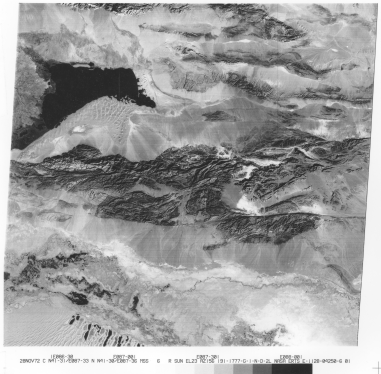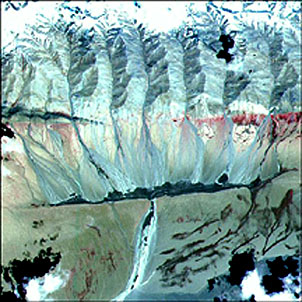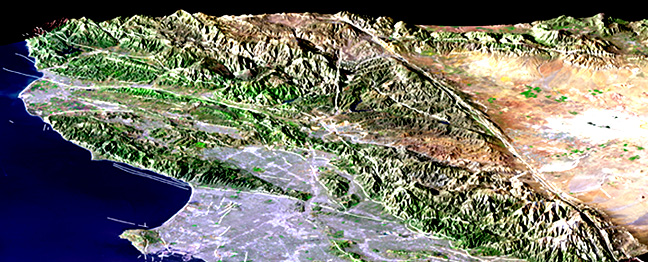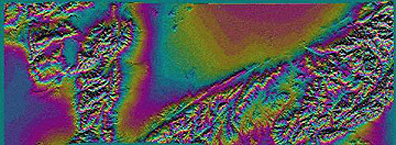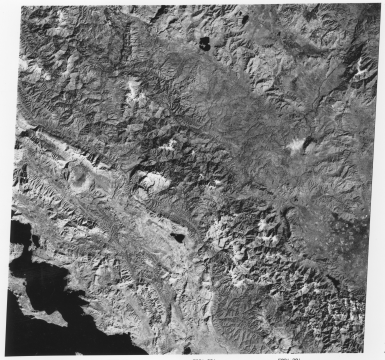Recognition of Faults and Joints¶
Another regional scale feature usually easy to recognize in suitable space imagery is that of faulting. A fault is a fracture in the Earth�s crust along which there has been some relative movement of rock on one side against the other side. This appears as some form of displacement or offset of once contiguous units. Joints are fractures that do not involve differential movement; they are usually too small in size to be directly recognizable from space but their effect on topography may reveal their presence. Two examples are shown.
Recognition of Faults and Joints¶
Faults are fractures along which there is relative sliding movement of the blocks in opposite directions on either side. We recognize them by various criteria:
Layers of different types and ages of rock units sit side-by-side
Abrupt topographic discontinuities of landforms
Depressions along the fault trace (broken rock is more easily eroded)
Scarps or cliffs
Sudden shifts of drainage courses.
Abrupt changes in vegetation patterns
Joints can be conspicuous under certains conditions, where they are long, continuous, wide-spaced and enlarged by erosion. This is well shown by the joint system cutting a basalt flow in Zambia over which flows the Zambesi River (Victoria Falls).
The scene below of the Kuruk Tagh fault in part of the Tian Shan mountains of westernmost China shows a sharp fault trace running east-west through the Kuruk Tagh hills. It’s composed of folded sedimentary strata, metamorphic rocks, and igneous intrusions. The block of crust on the north side has shifted sub-horizontally to the west (left) at least 60 km relative to the block containing the corresponding segment of mountains to the south. This type is a left-lateral wrench fault (also called a strike-slip fault). It’s a type similar to the San Andreas fault, which is a right-lateral fault, with the Pacific plate moving northward against the North American plate the famed earthquake-maker running from the Gulf of California through the California Coastal Ranges north of San Francisco (see the Los Angeles mosaic further down this page and the L.A. image in Section 4and the San Francisco images in Section 6).
Comparable to the San Andreas fault is the Dead Sea Fault that runs from just below the mountains of east Lebanon southward through the Sea of Galilee and the Dead Sea (both actually lakes), thence into the Gulf of Aqaba. This fault marks one of the three arms of the Afar Triple Junction (see page 17-3). Here it is shown in a mosaic made from two Landsat images.
The fault is recognized in part by topographic discontinuities (mountains in Jordan not fitting with those on the western side) and because the Jordan River and the two lakes follow zones of weakness that are erodes so that they are lower than their surroundings (land adjacent to the Dead Sea has the lowest elevation on land anywhere on Earth; in places below - 300 feet).
The Kuruk Tagh fault in east Asia, another strike-slip fault, is easy to identify because of topographic offset (as well as equivalent parts of the strata and metamorphosed rock units), fault scarps, and displaced drainage. This and similar major wrench faults in south-central Asia represent crustal adjustments to the stresses induced by the collision of India against Asia (see mosaic in Section 7).
` <>`__2-13: Can you find a second major fault in this scene? **ANSWER**
Another major fault zone in western China near Tibet is the Kunlun strike-slip (left lateral) system. In the ASTER image below, the fault has split into two parallel segments. The lower one has produced a topographic barrier against which water (black) has been impounded to form a long, narrow lake. Above a series of alluvial fans is the upper segment from within which water has emerged to flow downslope and to enable vegetation (red) to grow.
One of the best known and studied fault zones in the world makes up the East African Rift complex that runs from Ethiopia south through Kenya (see also Section 3, page 3-2. Here, a part of Africa is splitting off from the continental nucleus to its west, as an incipient mid-ocean ridge is forming by rifting centered on the Afar in Ethiopia. This image, extracted from a photo taken by astronauts using the Large Format Camera (LFC), shows a number of step faults (of the ‘normal’ type) which cuts into basaltic flows making up rift valleys:/p>
A region in the U.S. famed for its propensity to earthquakes is much of California from the Mexican border to about 100 km (62 miles) north of San Francisco. North of the Los Angeles Basin is a series of mountain ranges trending towards an east-west orientation. These collectively are known as the Transverse Ranges, and include the San Gabriel and Santa Monica Mountains north of Los Angeles. They are criss-crossed by faults that have a strong effect on their topography. Although most of these are wrench or strike-slip types of faulting (dominantly horizontal slip motion), they are capable of influencing the fronts of ranges in a manner similar to the normal-type of fault. Here is a perspective view of the Transverse Ranges made by combining Landsat imagery with topographic data acquired by JPL’s SRTM mission (radar altimetry). Fault lines (in white) have been drawn on the resulting image, which also depicts the Los Angeles Basin (bottom center) and the Mojave Desert (right).
No doubt the most famous fault in North America is the San Andreas, a major strike-slip type, that runs from the Gulf of California northward more or less parallel to the California coastline until it finally passes out to sea as a transverse fault in Bodega Bay north of San Francisco. In the ranges north of Los Angeles the San Andreas marks a prominent straight boundary with the southern Mojave Desert. This is evident in this image which is actually a beautifully produced aerial photomosaic that includes the Los Angeles Basin, with its many cities, to the south.
An aerial oblique photo shows the fault in an area of the Coast Ranges in the Carizzo Plains northeast of Morro Bay. The fault here has a small scarp or cliff to the west of which the land is slightly higher and dissected.
Segments of the San Andreas have been imaged by Landsat, SPOT, and radar systems many times. Here we show the latest example: an unusual portrayal of its appearance in a C-band image specially processed to give landform information, with elevation variation shown as a series of color bands. The imaging instrument is the Shuttle Radar Topography Mission (SRTM) that is discussed more fully in Section 11. Compare this image with the aerial photomosaic shown above: the straight boundary along the northern Tranverse Ranges in both images stands out. The image orientation is shifted somewhat from the mosaic, with the Mojave salient apex now pointing down at the left.
As is described in Section 11 and elsewhere, imagery coupled with elevation data (in STRM’s case, from its own stereo-like capability) can be recast in the perspective mode as though it is being viewed much like an aerial oblique photo. Here is an STRM construction of the topography west of Palmdale, Calif. (an earthquake-active area) in which a somewhat straight valley (holding the lake) roughly coincides with the San Andreas fault.
northern Transverse Ranges just south of the Mojave Desert. |
Wrench faults have nearly vertical fault planes (contact surfaces between blocks). A second fault type is the thrust fault, in which the fault plane is at low angles relative to Earth’s surface and the usual direction of movement carries the upper (near-surface) block over the lower block, causing rocks of different ages to be juxtaposed. Thus, a shallow, tabular slice of crust slides (thrusts) over the fault plane and on top of the surface ahead of it. Several such thrust slices (sheets) may stack one on top of the other in a staggered pattern, leading to a sequence of thrust block bands that outcrop in mountainous terrains. If each block consists of rock types that are different in composition and erosive response, these will appear at the surface as intervals of rock with contrasting topography. This topography is superbly displayed in the scene below of the Pindus Mountains of western Greece and Albania.
We can differentiate five tectonic zones, named in this generalized map, by sight because of distinct topographic variations and tonal differences related to contrasting rock types. The direction of tectonic transport is from east to west (right to left) causing the sheets to partially overlap below the surface, but each front edge occupies a different geographic position relative to the one it overrode and the one overriding it. This zone of thrust belts is part of the Balkan Alpine system, an offshoot of the European Alps that runs sub-parallel to the Apennine Mountains of Italy (see Alps mosaic in Section 7). As part of the tectonic adjustments caused by the African Plate shoving northward against the European Plate, a small tectonic plate underlying the Tyrrhenian Sea (off Sardinia) is squeezed against the Adriatic plate. The Adriatic plate then pushes it eastward against the Aegian plate, underthrusting it and causing the thrust slicing shown here.
` <>`__2-14: Which two tectonic zones are hardest to recognize and separate in the above image? **ANSWER**
